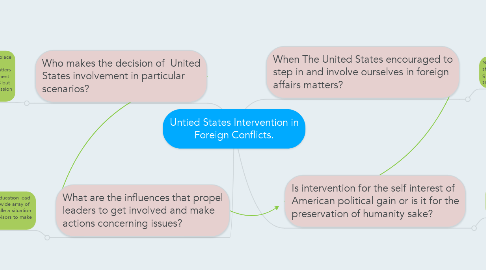Untied States Intervention in Foreign Conflicts.
by Caleb Glader


1. Who makes the decision of United States involvement in particular scenarios?
1.1. Identifying what the chain of command in place is to answer and come up with a solution. Department of State often heads these matters but usually in conjunction with the Department of Defense. Not all matters rest on POTUS but action is often achieved by the Chief of Mission in the their respectful area of control.
1.1.1. Department of State Structure. and previous examples of who took control in particular scenarios.
2. What are the influences that propel leaders to get involved and make actions concerning issues?
2.1. Background experience and education lead individuals to come up with a wide array of different ideas on how to handle a situation. Training must exist to lead advisors to make unbaised decisions.
2.1.1. Finding where leaders gained their training and experience from.
3. Is intervention for the self interest of American political gain or is it for the preservation of humanity sake?
3.1. It would be understandable that our national involvement would be encouraged for a result in political gain. In what case do we take action with the expectation of nothing in return.
3.1.1. Find examples of American hospitality.
4. When The United States encouraged to step in and involve ourselves in foreign affairs matters?
4.1. Natural disasters often merit U.S. aid to severely stricken regions. Armed conflicts are more of a gray area of who do we decide to support in such cases.
4.1.1. Look for evidence of trends produced in current foreign intervention situations.
